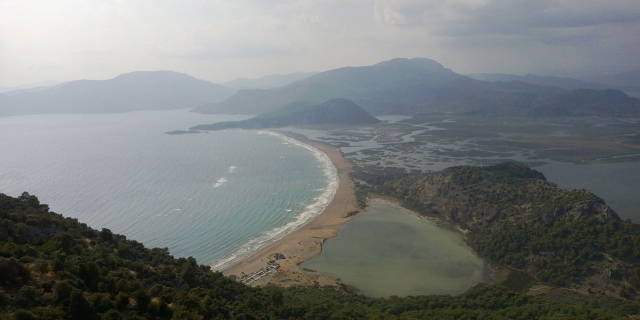Mira (antik kent)
( Myra )Myra (Ancient Greek: Μύρα, Mýra) was a Lycian, then ancient Greek, then Greco-Roman, then Byzantine Greek, then Ottoman town in Lycia, which became the small Turkish town of Kale, renamed Demre in 2005, in the present-day Antalya Province of Turkey. It was founded on the river Myros (Ancient Greek: Μύρος; Turkish: Demre Çay), in the fertile alluvial plain between Alaca Dağ, the Massikytos range and the Aegean Sea.
 Rock-cut tombs in Myra
Rock-cut tombs in Myra Rock-cut tombs in Myra
Rock-cut tombs in MyraAlthough some scholars equate Myra with the town, of Mira, in Arzawa, there is no proof for the connection.[citation needed] There is no substantiated written reference for Myra before it was listed as a member of the Lycian League (168 BC–AD 43); according to Strabo (14:665), it was one of the largest towns of the alliance.
The ancient Greek citizens worshiped Artemis Eleutheria, who was the protective goddess of the town. Zeus, Athena and Tyche were venerated as well. Pliny the Elder writes that in Myra there was the spring of Apollo called Curium and when summoned three times by the pipe the fishes come to give oracular responses.[1] In the Roman period, Myra formed a part of the Koine Greek speaking world that rapidly embraced Christianity. One of its early Greek bishops was Saint Nicholas.
Alluvial silts mostly cover the ruins of the Lycian and Roman towns. The acropolis on the Demre-plateau, the Roman theatre and the Roman baths (eski hamam) have been partly excavated. The semi-circular theatre was destroyed in an earthquake in 141, but rebuilt afterward.
There are two necropoleis of Lycian rock-cut tombs in the form of temple fronts carved into the vertical faces of cliffs at Myra: the river necropolis and the ocean necropolis. The ocean necropolis is just northwest of the theatre. The best-known tomb in the river necropolis, 1.5 km (0.93 mi) up the Demre Cayi from the theatre, is the "Lion's tomb", also called the "Painted Tomb". When the traveler Charles Fellows saw the tombs in 1840 he found them still colorfully painted red, yellow and blue.
 Lycian tomb relief at Myra, 4th century BC.[2]
Lycian tomb relief at Myra, 4th century BC.[2]Andriake was the harbor of Myra in ancient times, but silted up later on. The main structure there surviving to the present day is a granary (horrea) built during the reign of the Roman emperor Hadrian (117–138 AD). Beside this granary is a large heap of Murex shells, evidence that Andriake had an ongoing operation to produce purple dye.[3]
Excavations have been carried out at Andriake since 2009. The granary was turned into the Museum of Lycian Civilizations. The granary has seven rooms and measures 56 meters long and 32 meters wide. Artifacts found during the excavations in the Lycian League were placed in the museum. The structures in the harbor market as well as the agora, synagogue, and a six-meter deep, 24-meter long and 12-meter wide cistern were restored. A 16-meter-long Roman-era boat, a crane, and a cargo car were placed in front of the museum.[4]
In 1923, its Greek inhabitants was required to leave by the population exchange between Greece and Turkey, at which time its church was finally abandoned.



























Add new comment